-
 Health & Wellness
Health & WellnessMinimally Invasive Surgery Works Well for Abdominal Aortic Aneurysms, Mayo Finds
ROCHESTER, Minn. — September 4, 2012. A minimally invasive procedure known as endovascular repair used for abdominal aortic aneurysms has a low rate of complications, even in high-risk patients such as those with kidney, heart or lung problems, a Mayo Clinic study shows. Researchers found that even when aneurysms ruptured, endovascular repair had lower mortality rates than open-abdominal surgery, the other treatment option. The findings are being presented at the Midwestern Vascular Surgical Society Annual Meeting, Sept. 6-8, in Milwaukee, Wis.

MULTIMEDIA ALERT: Video resources, including
an illustration and interview with Dr. Gloviczki, are available for journalists at the Mayo Clinic News Network.
An abdominal aortic aneurysm is a weakened and bulging area in the lower part of the aorta, the major blood vessel that supplies blood to the body. A ruptured abdominal aortic aneurysm can cause life-threatening bleeding. In endovascular surgery, physicians attach a synthetic graft to the end of a thin tube, or catheter, inserted through a groin artery and threaded up into the aorta. The graft is placed at the site of the aneurysm and fastened in place, reinforcing the aorta to prevent rupture. Recovery time typically includes a day in the hospital and one or two weeks of rest at home, compared with five to seven days in the hospital and four to six weeks at home after open-abdominal surgery.
"During the last decade or so we have performed over 1,000 endovascular repairs of abdominal aortic aneurysms that included patients with no symptoms at all and patients who presented with a life-threatening rupture. We found that endovascular repair results in a low mortality and a low rate of complications, and that was very rewarding," says lead author Peter Gloviczki, M.D., a Mayo Clinic vascular and endovascular surgeon.
Using a Mayo Clinic aortic registry, researchers analyzed data from 1,008 consecutive patients receiving endovascular repair between 1997 and 2011.
Abdominal aortic aneurysms are more common in men than in women, and that was reflected in the cases studied: 133 were women and 875 were men. They ranged in age from 49 to 99, with a mean age of 76. Thirty-day mortality after repair of non-ruptured aneurysms was 0.2 percent in good-risk and 2.2 percent in high-risk patients. The five-year survival rate was 72 percent for good-risk patients and 51 percent for those at high risk; three-fourths of those in either group were free from early and late complications, which can include post-procedure bleeding, blood clots or problems with the repair.
Age and high surgical risk were associated with complications and early and all-cause death. Women were likelier than men to have complications, but weren't at higher risk of death.
Abdominal aortic aneurysms often develop without symptoms. Men with a family history of aneurysms should be screened at age 55 with abdominal ultrasounds. Smokers, people with high cholesterol or high blood pressure, and women with a family history of aneurysms should be screened at 65, says Dr. Gloviczki, the Joe M. and Ruth Roberts Professor of Surgery at Mayo Clinic and president of the Society for Vascular Surgery.
###
About Mayo Clinic:
Recognizing 150 years of serving humanity in 2014, Mayo Clinic is a nonprofit worldwide leader in medical care, research and education for people from all walks of life. For more information, visit 150years.mayoclinic.org, www.mayoclinic.org and newsnetwork.mayoclinic.org.
Media Contact: Sharon Theimer, 507-284-5005 (days), newsbureau@mayo.edu
Related Articles







